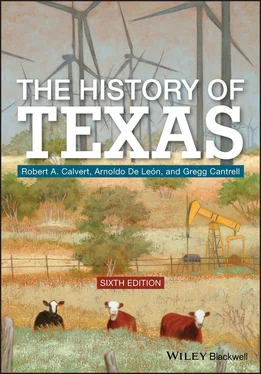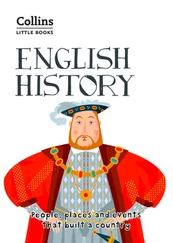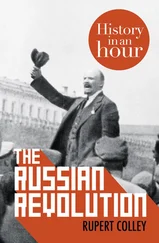Readings
Books and dissertations
1 Almaráz, Félix D. Tragic Cavalier: Governor Manuel Salcedo of Texas, 1808–1813. College Station: Texas A&M University Press, 1992.
2 Anderson, Gary Clayton. The Indian Southwest, 1580–1830: Ethnogenesis and Reinvention. Norman: University of Oklahoma Press, 1999.
3 Bannon, John Francis. The Spanish Borderlands Frontier, 1513–1821. New York: Holt, Rinehart, and Winston, 1970.
4 Barr, Juliana. Peace Came in the Form of a Woman: Indians and Spaniards in the Texas Borderlands. Chapel Hill: University of North Carolina Press, 2007.
5 Bolton, Herbert E. Texas in the Middle Eighteenth Century. 1915. Reprint, Berkeley: University of California Press, 1977.
6 Castañeda, Carlos E. Our Catholic Heritage in Texas, 1519–1936, 7 vols. Austin: Von Boeckmann‐Jones Co., 1936–1958.
7 Chipman, Donald E. Spanish Texas, 1519–1821. Austin: University of Texas Press, 1992.
8 ———, and Harriett Denise Joseph. Notable Men and Women of Spanish Texas. Austin: University of Texas Press, 1999.
9 Coronado, Raul. A World Not to Come: A History of Latino Writing and Print Culture. Cambridge, MA: Harvard University Press, 2013.
10 de la Teja, Jesús F. San Antonio de Béxar: A Community in New Spain’s Northern Frontier. Albuquerque: University of New Mexico Press, 1995.
11 Faulk, Odie B. A Successful Failure. Austin: Steck‐Vaughn Co., 1965.
12 Folsom, Bradley. Arredondo: Last Spanish Ruler of Texas and Northeastern New Spain. Norman: University of Oklahoma Press, 2017.
13 Hämäläinen, Pekka. The Comanche Empire. New Haven: Yale University Press, 2008.
14 Hickerson, Nancy Parrott. The Jumanos: Hunters and Traders of the South Plains. Austin: University of Texas Press, 1994.
15 Hinojosa, Gilberto M. A Borderlands Town in Transition: Laredo, 1755–1870. College Station: Texas A&M University Press, 1983.
16 Jackson, Jack. Los Mesteños: Spanish Ranching in Texas, 1721–1821. College Station: Texas A&M University Press, 1986.
17 John, Elizabeth. Storms Brewed in Other Men’s Worlds: The Confrontation of Indians, Spanish, and French in the Southwest, 1540–1795. College Station: Texas A&M University Press, 1975.
18 Jones, Oakah L. Los Paisanos: Spanish Settlers on the Northern Frontier of New Spain. Norman: University of Oklahoma Press, 1979.
19 La Vere, David. The Caddo Chiefdoms: Caddo Economics and Politics, 1700–1835. Lincoln: University of Nebraska Press, 1998.
20 ———. The Texas Indians. College Station: Texas A&M University Press, 2004.
21 MacLachlan, Colin M., and Jaime E. Rodríguez‐O. The Forging of the Cosmic Race: A Reinterpretation of Colonial Mexico. Berkeley: University of California Press, 1980.
22 McReynolds, James Michael. “Family Life in a Borderlands Community: Nacogdoches, Texas, 1779– 1861.” PhD diss., Texas Tech University, 1978.
23 Moorhead, Max L. The Presidio: Bastion of the Spanish Borderlands. Norman: University of Oklahoma Press, 1975.
24 Morfi, Juan Agustín. History of Texas, 1673–1779, translated by C. E. Castañeda. Albuquerque: Quivira Society, 1967.
25 Myers, Sandra L. The Ranch in Spanish Texas, 1691–1800. El Paso: Texas Western Press, 1969.
26 Newcomb, William W., Jr. The Indians of Texas: From Prehistoric to Modern Times. Austin: University of Texas Press, 1961.
27 Porter, Amy M. Their Lives, Their Wills: Women in the Borderlands, 1750–1846. Lubbock: Texas Tech University Press, 2015.
28 Poyo, Gerald E., and Gilberto M. Hinojosa, eds. Tejano Origins in Eighteenth‐Century San Antonio. Austin: University of Texas Press, 1991.
29 Ricklis, Robert A. The Karankawa Indians of Texas: An Ecological Study of Cultural Tradition and Change. Austin: University of Texas Press, 1996.
30 Smith, F. Todd. The Caddo Indians: Tribes at the Convergence of Empire, 1542–1854. College Station: Texas A&M University Press, 1995.
31 ——— From Dominance to Disappearance: The Indians of Texas and the Near Southwest, 1786–1859. Lincoln: University of Nebraska Press, 2005.
32 Tijerina, Andrés. Tejanos and Texas under the Mexican Flag, 1821–1836. College Station: Texas A&M University Press, 1994.
33 Torget, Andrew J. Seeds of Empire: Cotton, Slavery, and the Transformation of the Texas Borderlands, 1800–1850. Chapel Hill: University of North Carolina Press, 2015.
34 Weber, David J. The Mexican Frontier, 1821–1846: The United States Southwest under Mexico. Albuquerque: University of New Mexico Press, 1982.
35 ———. The Spanish Frontier in North America. New Haven, CT: Yale University Press, 1992.
36 Weddle, Robert S. San Juan Bautista: Gateway to Spanish Texas. Austin: University of Texas Press, 1968.
37 Wintz, Cary D. “Women in Texas.” In The Texas Heritage, 3rd ed., edited by Ben Procter and Archie P. McDonald, 185–208. Wheeling, IL: Harlan Davidson, Inc., 1998.
1 Bannon, John Francis. “The Mission as a Frontier Institution: Sixty Years of Interest and Research.” Western Historical Quarterly 10, no. 3 (July 1979): 303–22.
2 de la Teja, Jesús F. “Indians, Soldiers, and Canary Islanders: The Making of a Texas Frontier Community.” Locus 3, no. 1 (Fall 1990): 81–96.
3 Faulk, Odie B. “Ranching in Spanish Texas.” The Hispanic American Historical Review 45, no. 2 (May 1965): 257–66.
4 Poyo, Gerald E., and Gilberto M. Hinojosa. “Spanish Texas and Borderlands Historiography in Transition.” Journal of American History 75, no. 2 (September 1988): 393–416.
5 Tjarks, Alicia V. “Comparative Demographic Analysis of Texas, 1777–1793.” Southwestern Historical Quarterly 77, no. 3 (January 1974): 291–338.
6 Wright, Robert E. “The Hispanic Church in Texas under Spain and Mexico.” U.S. Catholic Historian 20, no. 4 (Fall 2002): 15–33.
3 Mexican Texas, 1821–1836
The execution of Miguel Hidalgo in 1811 by royalist forces did not end New Spain’s rebellion against the mother country. Another priest, José María Morelos, assumed command and committed the movement to a repudiation of the Spanish past. In Spain, meantime, the liberal Cortes (parliament) that had fought off Napoleon turned its attention to reform. Heeding the ideals of the Enlightenment, Spaniards penned the Constitution of 1812; the document forced King Ferdinand to acknowledge the will of the Cortes and provided the means by which people could gain better representation at all levels of government. An absolutist, Ferdinand suspended the constitution upon returning from exile in 1814, and Morelos’s capture and execution in 1815 spawned a royalist resurgence. Guerrilla bands carrying the Hidalgo/Morelos banner went underground for the next five years. Then, surprisingly, in 1820, liberalism returned to Spain when a military revolt coerced the king into reinstating the Constitution of 1812.
Alarmed, conservatives in New Spain–who had envisioned a nation retaining the basic foundations of the colonial era, but with themselves presiding over the society–considered independence preferable to living under a liberal rule that might well encourage the lower classes to challenge the social order. Agustín de Iturbide surfaced as the leader of this conservative faction, but he successfully recruited among the liberal resistance fighters who shared with him and the other conservatives the belief that liberation would be for the common good. In 1821, New Spain’s viceroy, realizing that the power of this expedient conservative/liberal coalition prevented the further subordination of the colony, recognized Mexico’s independence.
Finally free from the yoke of the Old World, Mexico confronted the task of forming its own kind of government. Liberals wished to mold a republic based on the liberal precepts of the Enlightenment and the Constitution of 1812. The conservatives, however, disliked the egalitarian ideas that Enlightenment thinking put into the minds of the lower classes. In a conservative countermove, Iturbide, who had been responsible for uniting all classes and political elements in Mexico behind the rallying cry of independence, centralized rule by establishing himself as emperor of Mexico. No sooner had he taken the throne, however, than he was denounced in the Plan de Casa Mata (issued in February of 1823), a liberal edict issued by a young military commander named Antonio López de Santa Anna. After successfully removing Iturbide from power in March 1823, the liberal supporters of the Plan de Casa Mata sought to solidify their victory by establishing a federalist republic.
Читать дальше










